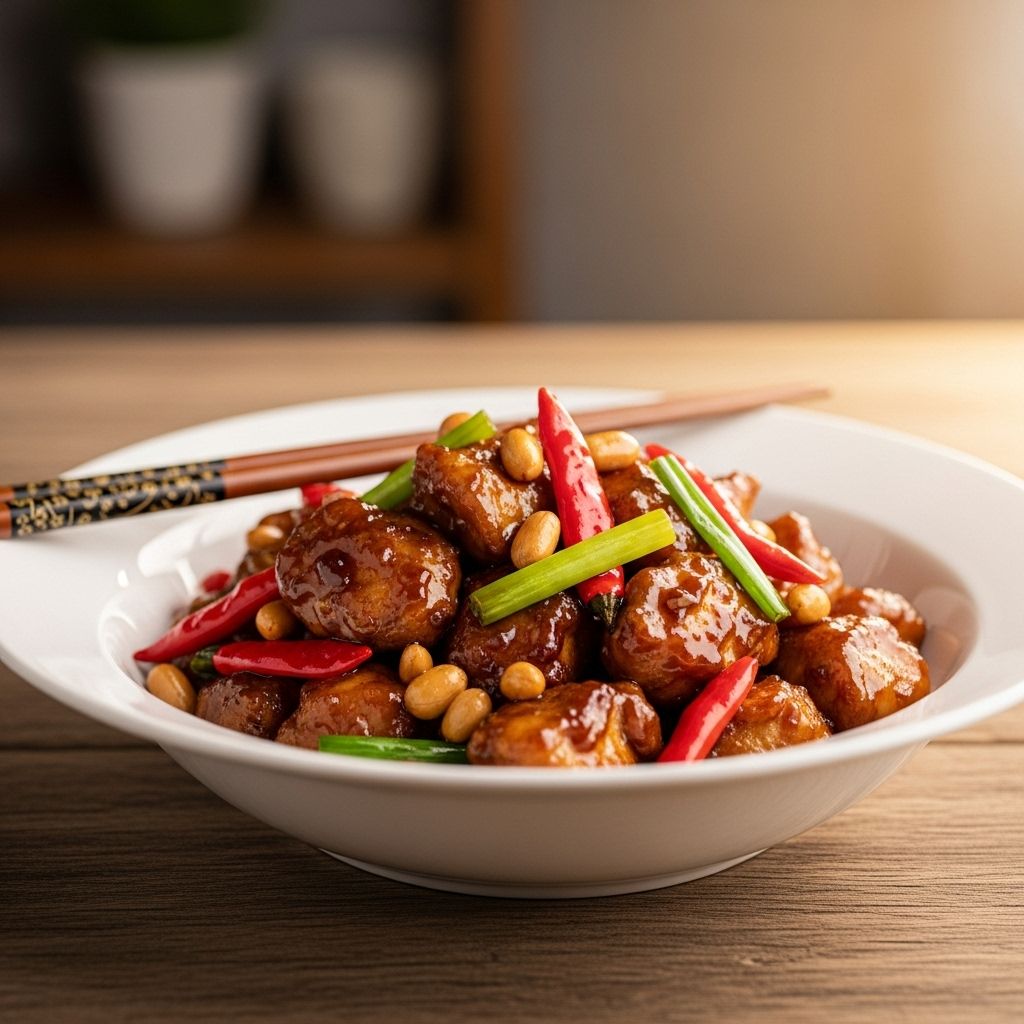Takeout-Style Kung Pao Chicken: 3 Essential Techniques At Home
Achieve authentic heat, crisp veggies, and a glossy, savory-sweet finish.

Takeout-Style Kung Pao Chicken: Ultimate Guide to Perfect Homemade Flavor
Kung Pao Chicken stands as a cornerstone of Chinese-American cuisine, celebrated for its vibrant heat, savory-sweet flavors, and delightful balance of crunchy peanuts and tender chicken. Whether you crave restaurant-style takeout or a homemade stir-fry packed with bold flavors, this comprehensive guide brings you every detail you need to master this iconic dish at home.
What Is Kung Pao Chicken?
Kung Pao Chicken—often seen on menus as “Diced Chicken with Hot Peppers and Peanuts”—is a stir-fried dish renowned for its colorful mix of chicken, dried chilies, crunchy peanuts, and a glossy savory-sweet sauce. The classic Chinese preparation, known as Gong Bao Ji Ding, has inspired numerous variations, with the Chinese-American takeout-style version focusing on a balance of sweet, spicy, and tangy flavors, along with crisp vegetables and tender protein.
Why Make Takeout-Style Kung Pao Chicken at Home?
- Personalized flavor: Adjust spice, sweetness, or tang to your liking.
- Quality control: Use the freshest chicken, vegetables, and peanuts for best results.
- Customization: Add or substitute vegetables, try different proteins, or dial up the heat with authentic Sichuan peppercorns.
- Cost-effective: Enjoy restaurant quality at a fraction of the price.
Key Concepts and Ingredients
Understanding the main flavor profiles and the importance of particular techniques is central to creating great Kung Pao Chicken.
- Marinated chicken: Tender chicken pieces are marinated briefly for flavor and juiciness.
- Crisp-tender vegetables: Bell peppers and celery provide color and crunch.
- Dried chilies: Infuse the oil and sauce with a gentle heat—adjust to taste.
- Peanuts: Roasted peanuts add classic crunch and a nutty finish.
- Glossy sauce: A balance of soy sauce, vinegar, sugar, and cornstarch yields the dish’s signature shine and flavor.
Main Ingredients List
- Boneless, skinless chicken thighs (or breast)
- Soy sauce
- Shao Xing wine or dry sherry
- Toasted sesame oil (optional)
- Cornstarch
- Vegetable oil or peanut oil (for high-heat cooking)
- Bell peppers (red or green)
- Celery (or scallions, or other crunchy vegetables)
- Dried red chilies
- Roasted unsalted peanuts
- Garlic and ginger (aromatic base)
- Vinegar (preferably Chinkiang or rice vinegar)
- Sugar
- Oyster sauce (optional, adds depth)
Optional Additions and Variations
- Sichuan peppercorns for authentic numbing spice
- Scallions or leeks for added flavor
- Other vegetables: zucchini, snap peas, carrots, or broccoli
The Secret Techniques Behind Great Kung Pao Chicken
Achieving that pristine, restaurant-quality texture and flavor comes down to three essential techniques:
- Marinate the protein—Briefly marinate chicken in soy sauce, a touch of cornstarch, and rice wine or sherry. This deeply flavors the meat and ensures tenderness.
- Fry the chicken and vegetables separately—Cook the chicken so it gets a bit of color, then remove while you cook peppers and aromatics separately, before bringing everything together. This prevents overcrowding the wok so the ingredients fry, not steam.
- Finish with a cornstarch-thickened sauce—Add the sauce only at the end; it thickens quickly and coats every bite.
Step-by-Step: How to Make Takeout-Style Kung Pao Chicken
This method delivers tender chicken, crisp vegetables, and perfectly layered sauces. Here’s the process detailed step by step:
1. Marinate the Chicken
- Dice chicken into small, even cubes for quicker, more uniform cooking.
- Toss with a mixture of soy sauce, Shaoxing wine (or dry sherry), oil, and cornstarch.
- Let marinate 15-30 minutes. This step is crucial for flavor and texture.
2. Prepare the Sauce
Mix all sauce ingredients in advance so you can add them quickly during stir-frying. Key components include:
- Soy sauce for savoriness
- Vinegar for tang
- Sugar for balancing sweetness
- Oyster sauce for depth (optional, but recommended for complexity)
- Cornstarch to thicken
- Water or chicken stock for volume
3. Prepare Vegetables and Aromatics
- Dice bell peppers and celery (or your choice of vegetables) into bite-sized pieces about the same size as the chicken.
- Slice garlic and mince fresh ginger for aromatic foundation.
4. Stir-Fry
- Heat oil in a large wok or skillet until just starting to smoke. Add the dried chilies and, if using, Sichuan peppercorns. Stir to infuse oil (and, for extra smoky depth, consider using a culinary torch for a hit of wok hei as in some restaurant kitchens).
- Add marinated chicken; stir-fry until almost cooked through and starting to brown.
- Remove chicken; add more oil if needed, then stir-fry bell peppers, celery, and aromatics just until crisp-tender.
- Return chicken to the wok, add sauce, and stir constantly until the sauce thickens and glazes all components.
- Toss in roasted peanuts and green onions (if using), then remove from heat.
Tips and Substitutions
- Protein: Use chicken thighs for juiciness and flavor; breast works for a leaner result.
- Vegetarian/Vegan: Substitute tofu or tempeh for chicken and use mushroom-based sauce.
- Nut-free: Replace peanuts with toasted sunflower or pumpkin seeds.
- Spice level: Adjust number/type of dried chilies; omit seeds for less heat; add peppercorns for tongue-tingling sensation.
- Freshness: Always toast nuts and peppercorns for best flavor before adding.
- Tender veggies: Keep bell peppers and celery slightly crisp by cooking only briefly over high heat.
Serving Suggestions
- Serve hot over steamed white rice, brown rice, or fried rice.
- Garnish with extra peanuts and sliced scallions.
- Add a side of simple stir-fried greens or cucumber salad for a refreshing contrast.
Frequently Asked Questions (FAQs)
Q: Can I make this dish ahead of time?
A: The dish is best served immediately after cooking for optimal texture. However, you can prep all ingredients in advance and stir-fry just before serving. Leftovers will keep refrigerated for up to two days, but the vegetables may soften over time.
Q: What makes restaurant Kung Pao Chicken taste special?
A: High heat for true stir-fry flavor, proper marination for tender chicken, and layering of aromatics (like ginger, garlic, and dried chilies) are essential for that signature restaurant style. Some restaurants also add a smoky “wok hei” by briefly torching the ingredients, adding a touch of char and complexity.
Q: How can I substitute dried chilies if I can’t find them?
A: Use fresh red chili, Thai chili, or even a pinch of dried red pepper flakes. Adjust quantity for desired heat.
Q: Are Sichuan peppercorns necessary?
A: They are traditional to Kung Pao Chicken for a unique numbing sensation and complex citrusy flavor. If unavailable, the dish will still be delicious, though less authentic in profile. Black peppercorns are not a substitute.
Q: Can I make Kung Pao Chicken gluten-free?
A: Yes—use gluten-free tamari or coconut aminos in place of soy sauce, and ensure that all packaged ingredients are certified gluten-free.
Table: Ingredient Substitution Guide
| Original Ingredient | Substitution(s) |
|---|---|
| Chicken thigh | Chicken breast, tofu, tempeh, shrimp |
| Peanuts | Cashews, sunflower seeds, pumpkin seeds |
| Soy sauce | Gluten-free tamari, coconut aminos |
| Shaoxing wine | Dry sherry, mirin (less authentic), rice wine vinegar (reduce vinegar elsewhere) |
| Bell pepper | Broccoli, zucchini, snow peas |
| Dried chili | Fresh red chili, Thai chili, crushed red pepper flakes |
| Cornstarch | Potato starch, arrowroot powder |
Expert Tips for Perfect Kung Pao Chicken Every Time
- Do all prep before you start cooking. Stir-fries move fast; having all ingredients diced and measured prevents burning and ensures even cooking.
- High heat is key. Use the hottest burner on your stove; consider cast iron if you don’t have a wok.
- Don’t crowd the pan. Cook chicken in batches if needed. Overcrowding leads to steaming, not frying, and diminishes flavor.
- Add sauce at the end so that cornstarch thickens quickly, giving a glossy glaze rather than a soupy consistency.
- Balance the flavors. Taste the sauce before adding; adjust sugar, vinegar, and salt to your preference.
- Play with texture. For extra crunch, add water chestnuts or more nuts just before serving.
Recipe Customization Ideas
- Add extra vegetables such as zucchini, carrots, or mushrooms for a bulkier stir-fry.
- Make it extra-hot by doubling the chili or adding chili oil to the sauce.
- Edge toward the authentic by including a teaspoon or two of freshly ground Sichuan peppercorns, infusing both heat and numbing complexity.
Common Mistakes and How to Avoid Them
- Stir-frying wet ingredients: Pat chicken and vegetables dry to avoid excess moisture, which makes stir-fries soggy.
- Overcooking vegetables: Stir-fry only briefly; the goal is vibrant color and gentle crunch.
- Adding sauce too soon: Wait until all ingredients are about 90% cooked before adding the sauce for thick, shiny results.
Nutritional Highlights
- High in protein
- Moderately low in carbohydrates when served with steamed rice
- Healthy fats from peanuts and oils
- Loaded with vitamins from fresh vegetables
- Customization allows for gluten-free, low-carb, or veggie-rich versions
Final Thoughts
Takeout-style Kung Pao Chicken is more than just a quick meal—it’s a celebration of flavor, color, and texture. Master this dish at home with care and attention, and your kitchen will rival the best takeout around. Play with the ingredients and spice until it’s perfect for your palate, and never settle for lackluster stir-fry again!
Frequently Asked Questions (FAQs)
Q: Is Kung Pao Chicken spicy?
A: Yes, authentic versions are meant to be spicy from dried chilies (and sometimes Sichuan peppercorns). The spice level is adjustable at home.
Q: Can I freeze leftover Kung Pao Chicken?
A: Freezing is possible, but vegetables and nuts may become softer after thawing. Store in airtight containers for up to two months.
Q: What rice is best to serve with Kung Pao Chicken?
A: Steamed jasmine or long-grain white rice is classic, but brown rice or cauliflower rice are excellent options as well.
Q: How to keep the chicken extra juicy?
A: Use thigh meat, marinate well, and avoid overcooking. Quick, high-heat stir-frying seals in juices.
Q: What other dishes pair well with Kung Pao Chicken?
A: Try serving with steamed bok choy, egg drop soup, or simple cucumber salad for a full Chinese-American meal.
References
Read full bio of Shinta












